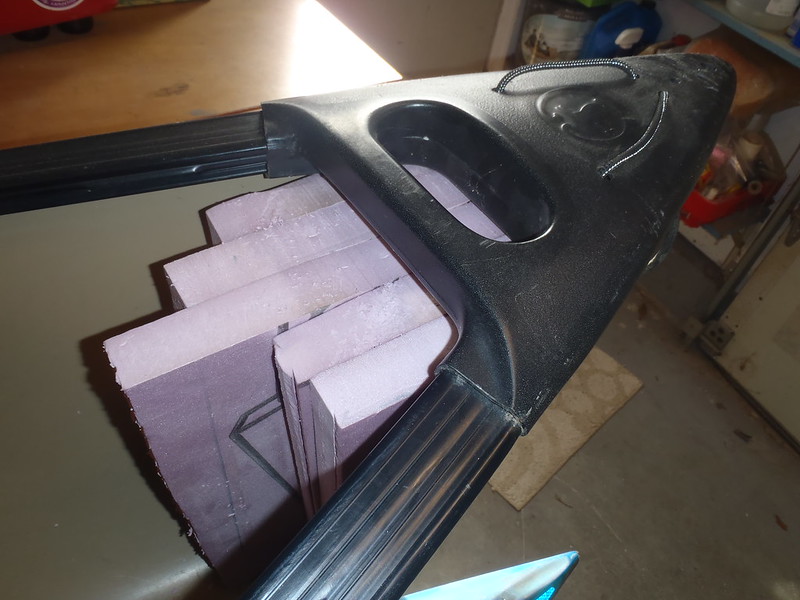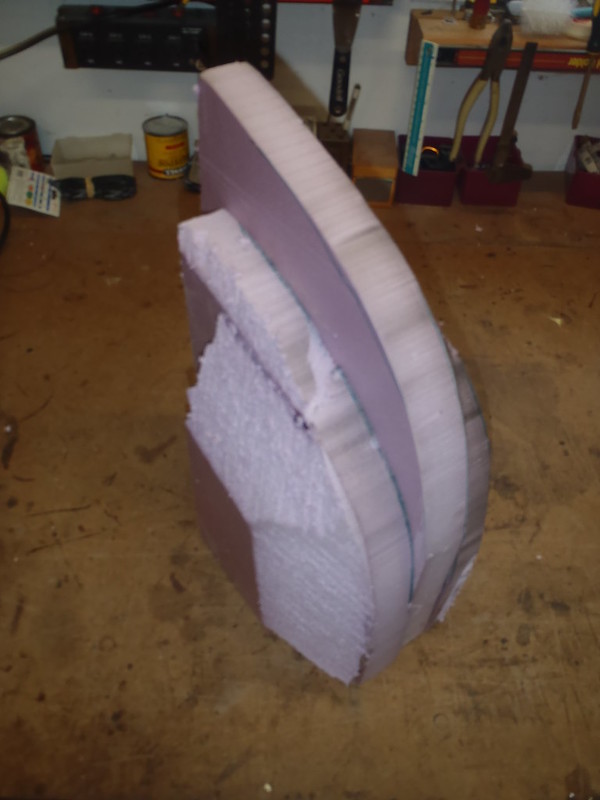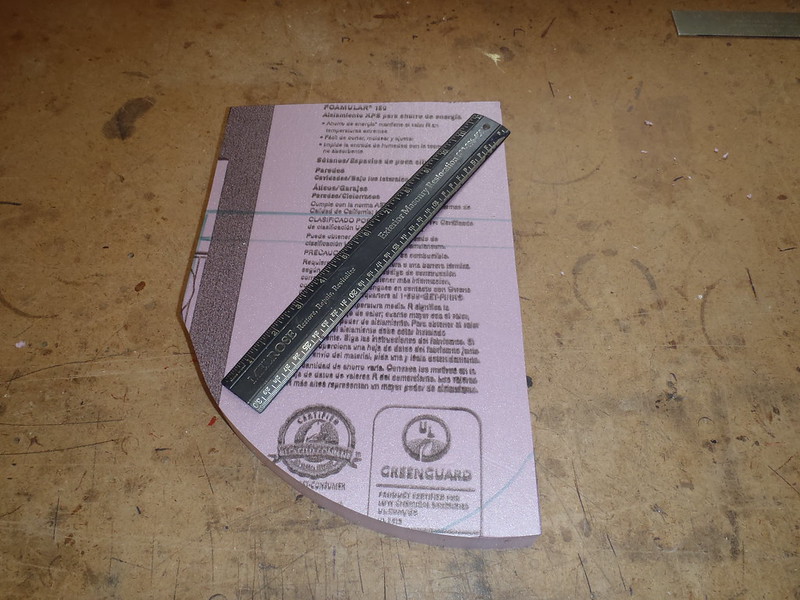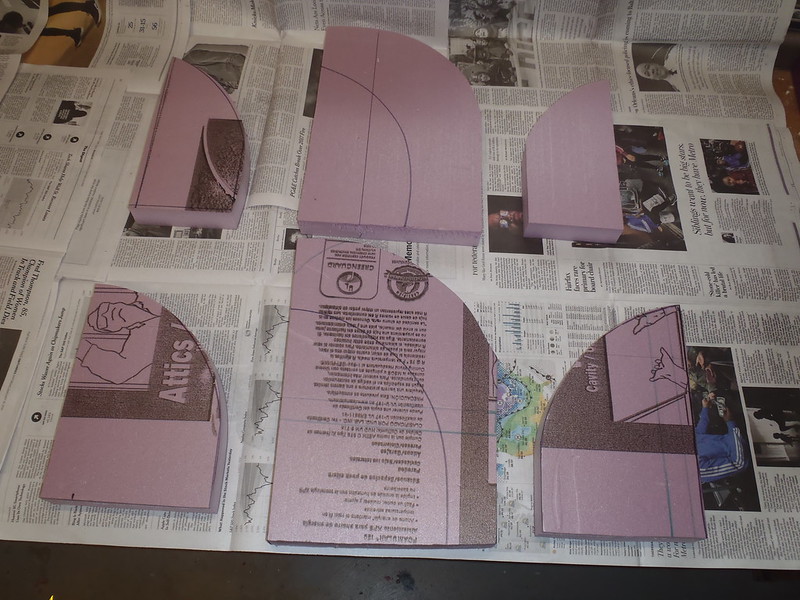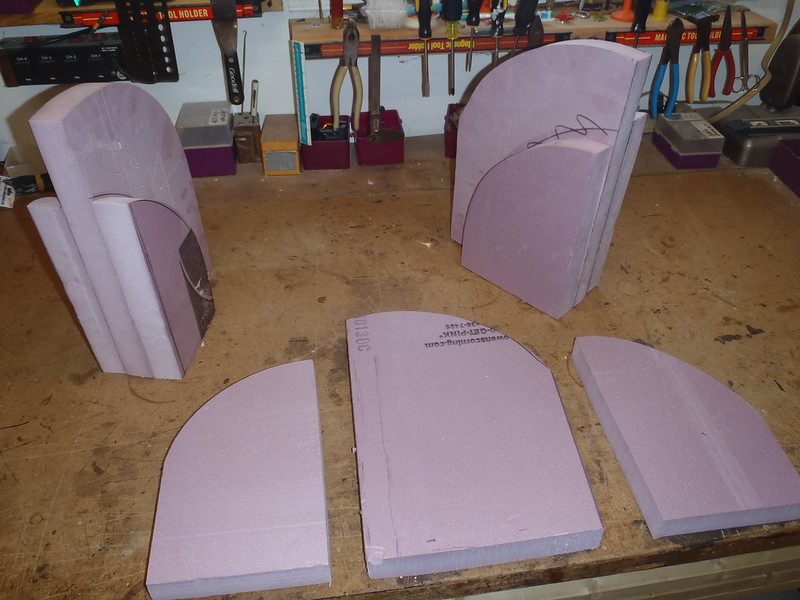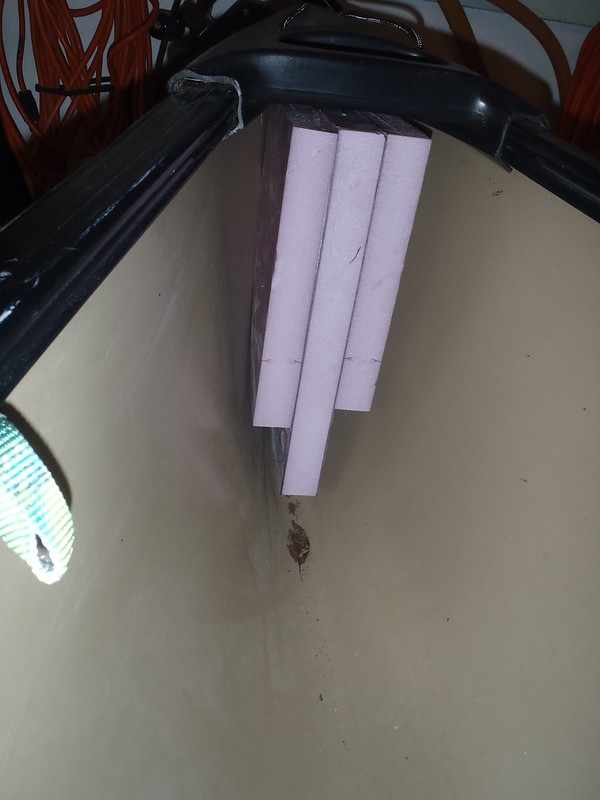G
Guest
Guest
I was really just doing this for my own shop play with leftover materials, but mentioned it to a friend who, unbeknownst to me, also has bird nest and canoe issues. What’s that German word? “Schadenfreude”, I’m not really deriving pleasure from his misfortunes, but was happy to have wren nesting company.
Nests we got. We have a lot of bird feeders. And a lot of birds, including house wrens. And a bunch of boats stored outside. That is not a good mix
Something about the underside of the deck plates on a racked canoe is a too-enticing nest cavity for house wrens. Wrens can build a nest in mere days. Worse, they can re-build a nest just as quickly. Worst, sometimes I forget to check and eggs go splat on the windshield after I have driven away with a canoe.
The original nest cavity preventers are nothing more than dollar store mini beach balls. Half-inflated and stuffed into the stems, occluding any potential nest platform. Well, not just “stuffed”; windy days will dislodge them unless secured, so I run a piece of cord through the inflation tube cap and tie that off, poked out through the deck plate drain holes, same as I do to secure some end floatation bags pulled fully into the vee of the stems.
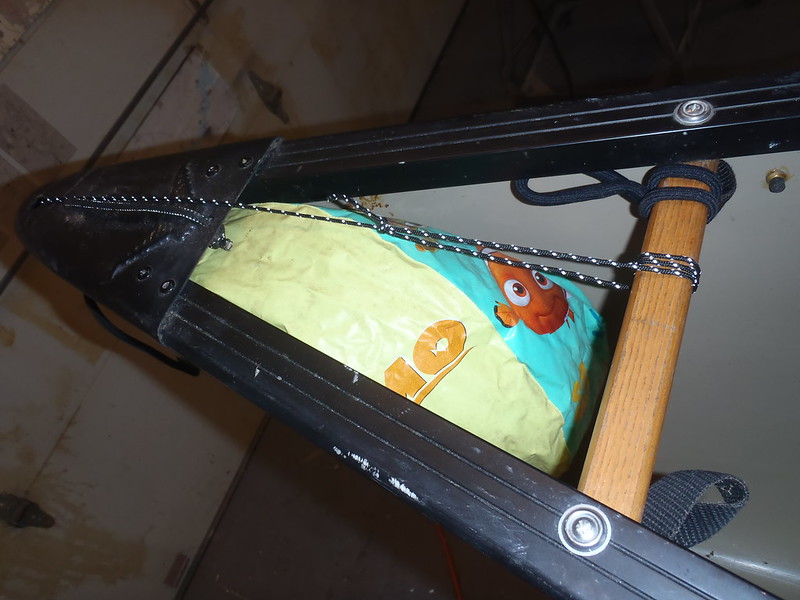 P1280001 by Mike McCrea, on Flickr
P1280001 by Mike McCrea, on Flickr
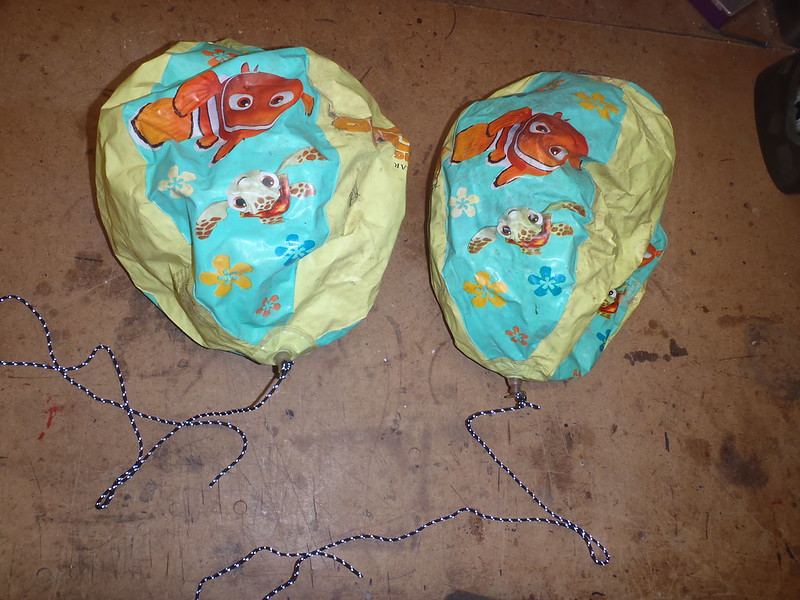 P1280004 by Mike McCrea, on Flickr
P1280004 by Mike McCrea, on Flickr
Those Dollar Store mini beach balls are old, maybe older than I thought; “Finding Nemo” came out a decade ago. Actually, in 2003. Though dirty they surprisingly still hold air with no leaks, probably because they are hidden from any UV exposure
The beach ball problem lies with “poke a string out through the deck plate drain hole”. It is a PITA groping blindly up underneath the far tip of the stem trying to poke the cord out the drain hole, especially if there is a painter loop through the hull and bungee knotted under the deck plate in the way. In any case my fingers don’t fit all the way to the tip of the stem, so I’m blindly poking away with a doopy cord end held at a distance.
That blind cord poking is no fun even with something less routine, like securing flotation bags with a cord through a tapered-end grommet, but when I forget and storage rack the canoe at home without first installing the nest preventer it is even more problematic. It’s easiest if I remember to plug the beach balls in place while the canoe is still on the truck racks after a trip, and remember to take them out when loading, with the hull at a convenient and exposed work height.
I do remember to take them out before driving away, they are garish visible when tying down. I don’t always remember to reinstall the beach ball preventers once back home, when they are uninstalled invisible waiting in the shop somewhere.
BTW, if you tie off float bags, or anything else held secure in the V of the stem, blindly poking a floppy cord at the drain hole doesn’t need to be that hard. I drill large drain holes, so an egg sack or bit of duff can’t plug them up, but poking cord at even a ½” hole was often overly frustrating. See also fat feeble fingers don’t fit.
You can drop a piece of cord through the drain hole, tie that off to the float bag cord, pull that up through the deck plate hole and untie the excess. A quicker and easier solution is to simply pass (not even tie) the bitter end of the float bag cord through a small loop on the end of a stiff wire guide, and poke that wire through the hole from underneath. A 6” length of coat hanger with a closed loop end helps find the hole without undue frustration.
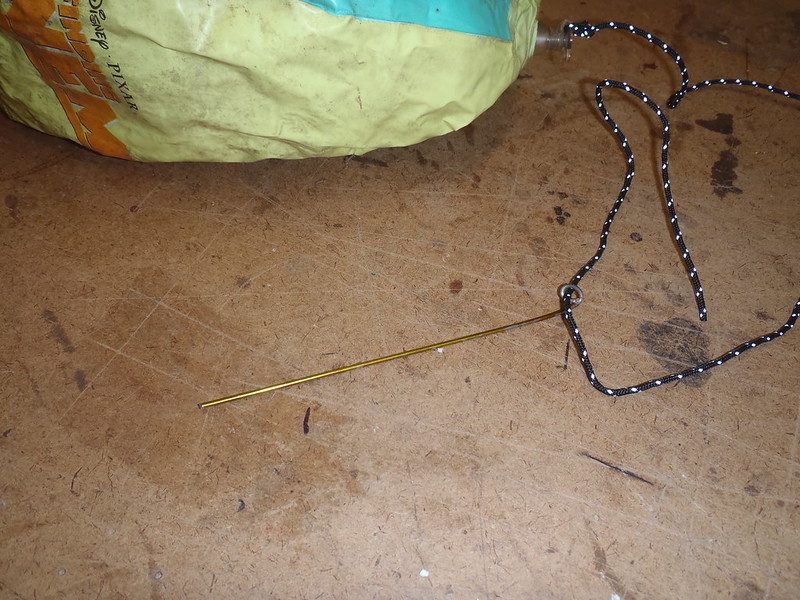 P1280006 by Mike McCrea, on Flickr
P1280006 by Mike McCrea, on Flickr
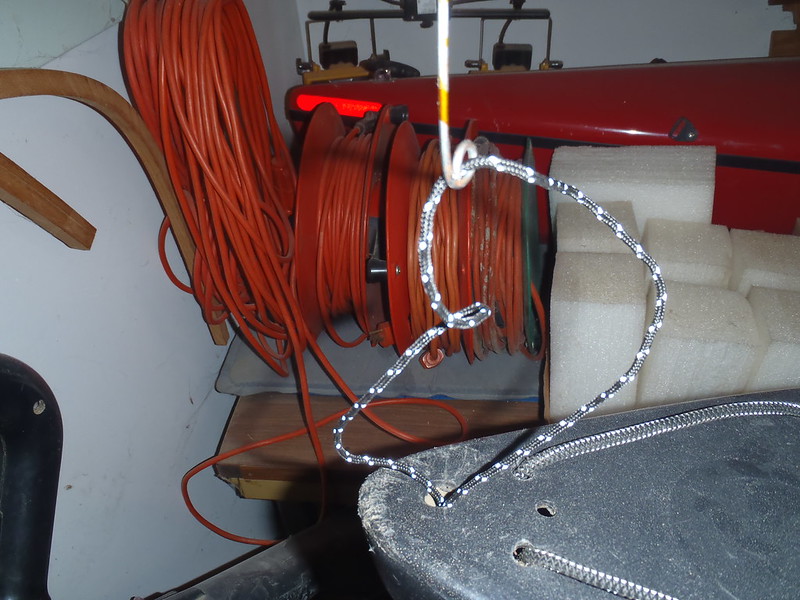 P1280009 by Mike McCrea, on Flickr
P1280009 by Mike McCrea, on Flickr
The Mark II cavity preventers were much more efficient to use; some big chunks of scrap ethafoam cut to shape and wedged into the stems. Those are especially convenient when I forget to install the nest cavity plugs before putting the canoe back on the racks; I can just reach overhaed and stuff them in place.
Thick ethafoam wedges, custom cut (and canoe marked, “Wilderness Stern, Wilderness Bow). With a raised portion that seats against the carry handles, those ethafoam blocks, simply stuffed in place, are held securely windproof via the carry handle block, but I only had enough thick ethafoam scrap for make a couple sets.
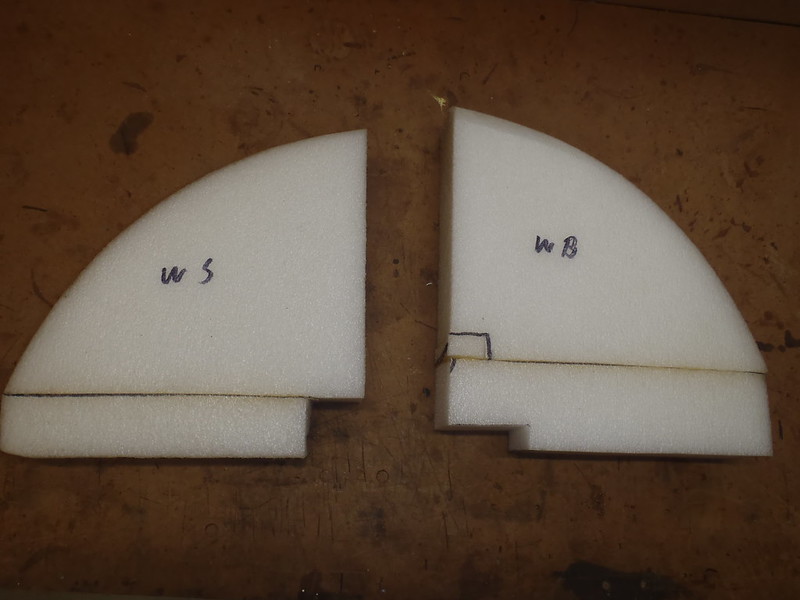 P1280011 by Mike McCrea, on Flickr
P1280011 by Mike McCrea, on Flickr
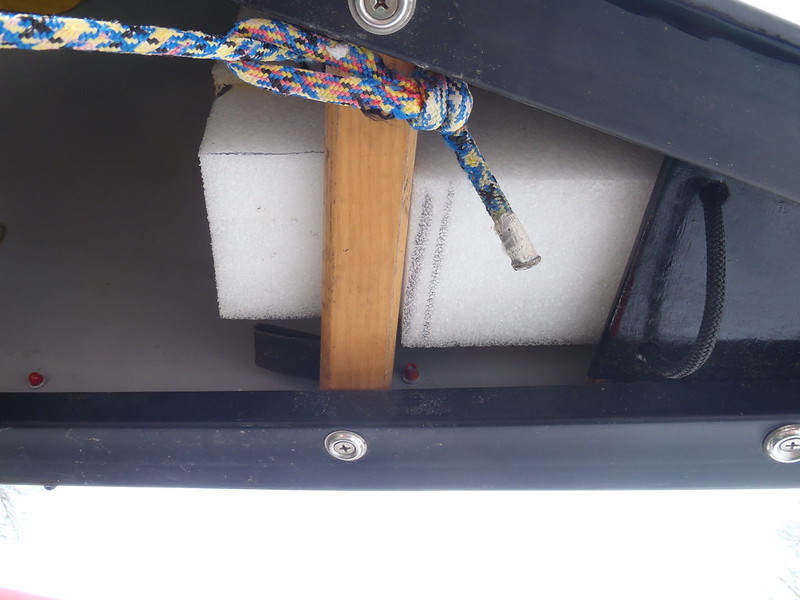 P2030031 by Mike McCrea, on Flickr
P2030031 by Mike McCrea, on Flickr
I like the ease and efficiency of those foam blocks, and what I do have left is some 1 ½” thick Pink Panther foamboard and lots of (why 3 partial cans?) spray adhesive. Enough foam board to make a few trial and error design mistakes. And I have ideas for something more universal.
Nests we got. We have a lot of bird feeders. And a lot of birds, including house wrens. And a bunch of boats stored outside. That is not a good mix
Something about the underside of the deck plates on a racked canoe is a too-enticing nest cavity for house wrens. Wrens can build a nest in mere days. Worse, they can re-build a nest just as quickly. Worst, sometimes I forget to check and eggs go splat on the windshield after I have driven away with a canoe.
The original nest cavity preventers are nothing more than dollar store mini beach balls. Half-inflated and stuffed into the stems, occluding any potential nest platform. Well, not just “stuffed”; windy days will dislodge them unless secured, so I run a piece of cord through the inflation tube cap and tie that off, poked out through the deck plate drain holes, same as I do to secure some end floatation bags pulled fully into the vee of the stems.
 P1280001 by Mike McCrea, on Flickr
P1280001 by Mike McCrea, on Flickr P1280004 by Mike McCrea, on Flickr
P1280004 by Mike McCrea, on FlickrThose Dollar Store mini beach balls are old, maybe older than I thought; “Finding Nemo” came out a decade ago. Actually, in 2003. Though dirty they surprisingly still hold air with no leaks, probably because they are hidden from any UV exposure
The beach ball problem lies with “poke a string out through the deck plate drain hole”. It is a PITA groping blindly up underneath the far tip of the stem trying to poke the cord out the drain hole, especially if there is a painter loop through the hull and bungee knotted under the deck plate in the way. In any case my fingers don’t fit all the way to the tip of the stem, so I’m blindly poking away with a doopy cord end held at a distance.
That blind cord poking is no fun even with something less routine, like securing flotation bags with a cord through a tapered-end grommet, but when I forget and storage rack the canoe at home without first installing the nest preventer it is even more problematic. It’s easiest if I remember to plug the beach balls in place while the canoe is still on the truck racks after a trip, and remember to take them out when loading, with the hull at a convenient and exposed work height.
I do remember to take them out before driving away, they are garish visible when tying down. I don’t always remember to reinstall the beach ball preventers once back home, when they are uninstalled invisible waiting in the shop somewhere.
BTW, if you tie off float bags, or anything else held secure in the V of the stem, blindly poking a floppy cord at the drain hole doesn’t need to be that hard. I drill large drain holes, so an egg sack or bit of duff can’t plug them up, but poking cord at even a ½” hole was often overly frustrating. See also fat feeble fingers don’t fit.
You can drop a piece of cord through the drain hole, tie that off to the float bag cord, pull that up through the deck plate hole and untie the excess. A quicker and easier solution is to simply pass (not even tie) the bitter end of the float bag cord through a small loop on the end of a stiff wire guide, and poke that wire through the hole from underneath. A 6” length of coat hanger with a closed loop end helps find the hole without undue frustration.
 P1280006 by Mike McCrea, on Flickr
P1280006 by Mike McCrea, on Flickr P1280009 by Mike McCrea, on Flickr
P1280009 by Mike McCrea, on FlickrThe Mark II cavity preventers were much more efficient to use; some big chunks of scrap ethafoam cut to shape and wedged into the stems. Those are especially convenient when I forget to install the nest cavity plugs before putting the canoe back on the racks; I can just reach overhaed and stuff them in place.
Thick ethafoam wedges, custom cut (and canoe marked, “Wilderness Stern, Wilderness Bow). With a raised portion that seats against the carry handles, those ethafoam blocks, simply stuffed in place, are held securely windproof via the carry handle block, but I only had enough thick ethafoam scrap for make a couple sets.
 P1280011 by Mike McCrea, on Flickr
P1280011 by Mike McCrea, on Flickr P2030031 by Mike McCrea, on Flickr
P2030031 by Mike McCrea, on FlickrI like the ease and efficiency of those foam blocks, and what I do have left is some 1 ½” thick Pink Panther foamboard and lots of (why 3 partial cans?) spray adhesive. Enough foam board to make a few trial and error design mistakes. And I have ideas for something more universal.

